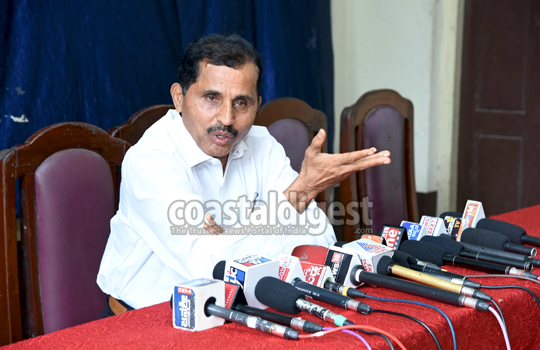Mangaluru, Jun 28: Expelled Congress leader Harikrishna Bantwal has accused Dakshina Kannada district in-charge minister B Ramanath Rai of abusing Congress veteran B Janardhana Poojary in public and igniting communal clashes in Bantwal for political gains.

Speaking to media persons in the city on Wednesday, Mr Bantwal, “revealed” that Mr Rai had used Tulu Nadu’s extreme derogatory words like “‘ra***maga’ and ‘nayisoo***maga’” against Mr Poojary in a fully crowded wedding hall nearly five months ago.
“MR Rai had attended a certain Rajesh’s wedding in Surathkal Buntara Bhavana on February 6, 2017. Local Congress leaders Arun Coelho and Tejaswi Raj too were present there. Mr Rai asked them where Mr Poojary was using the above mentioned words and further abused him in Tulu,” he said.
Interestingly, Mr Bantwal revealed the five month old incident for the first time a day after Harish Kumar, a leader of Billava community was made the president of Dakshina Kannada district Congress Committee. The appointment was seen as an apparent attempt by the Congress to woo Billavas in the coastal district in the wake of community stalwart Janardhana Poojary’s dissidence with the party leaders.
Lashing out at the Bunt stalwart, Mr Bantwal said that Mr Rai owes his political position today to Mr Poojary. “Back in 1985, when Mr Rai was nobody in the party, he secured the ticket to contest from Bantwal constituency because of Mr Poojary,” he said.
“Billawas and Bunts are the majority and strengths of this region. They cannot be without each other. We do not believe in seeing them as different communities. But some people always get caste into politics”, he said.
He also said that national leaders like Indira Gandhi, Rajiv Gandhi, Atal Bihari Vajpayee, A K Anthony always praised Mr Poojary and called him an honest politician, but Rai never valued him.
Justifying Mr Poojary’s recent outburst against his own party men in the state, Mr Bantwal said: “This is a democracy. People are allowed to criticize others.”
“Though Mr Poojary often criticized the chief minister, the former never used any unconstitutional or derogatory words against anyone”, he added. Calling Mr Rai an unfaithful and ungrateful, he said that Dakshina Kannada doesn’t need a politician like Mr Rai.
Mr Bantwal went on to say that being a follower of Sri Narayana Guru, he believed in being true to his religion, but also being an Indian first. “Nobody likes to fight. Some greedy politicians like Mr Rai create communal clashes for vote bank. Transferring police officers won’t solve problems in Bantwal. It is Mr Rai who needs to be stripped off his power to restore peace here”, he said.
Mr Bantwal also accused Mr Rai of always being on the side of ‘note and vote’. He called him a ‘modern day Shishupala’ and said that ‘Krishna’ had waited long enough and cannot hold it in anymore, it is time to show Mr Rai’s true colors to the people who voted him to power.





Comments
Pokkade
Ra*** maga means what? Raayara Maga?
Ra***maga means Raithana maga tats all
Add new comment